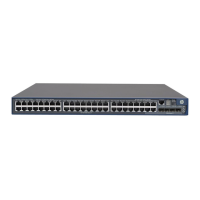102
Use the undo dot1x auth-fail vlan command to restore the default.
By default, no Auth-Fail VLAN is configured on a port.
You must enable MAC-based VLAN for an Auth-Fail VLAN to take effect on a port that performs MAC-
based access control.
When you change the access control method from MAC-based to port-based on a port that carries an
Auth-Fail VLAN, the mappings between MAC addresses and the 802.1X Auth-Fail VLAN are removed.
You can use the display mac-vlan command to display MAC-to-VLAN mappings.
You must enable 802.1X multicast trigger function for an Auth-Fail VLAN to take effect on a port that
performs port-based access control.
When you change the access control method from port-based to MAC-based on a port that is in an Auth-
Fail VLAN, the port is removed from the Auth-Fail VLAN.
To delete a VLAN that has been configured as an Auth-Fail VLAN, you must remove the Auth-Fail VLAN
configuration first.
Related commands: dot1x and dot1x port-method.
Examples
# Configure VLAN 3 as the Auth-Fail VLAN for port GigabitEthernet 1/0/1.
<Sysname> system-view
[Sysname] interface gigabitethernet 1/0/1
[Sysname-GigabitEthernet1/0/1] dot1x auth-fail vlan 3
dot1x guest-vlan
Syntax
In system view:
dot1x guest-vlan guest-vlan-id [ interface interface-list ]
undo dot1x guest-vlan [ interface interface-list ]
In Layer 2 Ethernet interface view:
dot1x guest-vlan guest-vlan-id
undo dot1x guest-vlan
View
System view, Layer 2 Ethernet interface view
Default level
2: System level
Parameters
guest-vlan-id: Specifies the ID of the VLAN to be specified as the 802.1X guest VLAN, in the range 1 to
4094. It must already exist. Ensure that the VLAN has been created and is not a super VLAN. For more
information about super VLANs, see the Layer 2
—
LAN Switching Configuration Guide. Only the A5500
EI Switch Series supports configuring super VLANs.
interface interface-list: Specifies a port list. The interface-list argument is in the format of interface-list = {
interface-type interface-number [ to interface-type interface-number ] } & <1-10>, where interface-type
represents the port type, interface-number represents the port number, and & <1-10> means that you can

